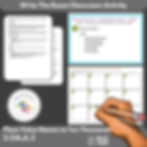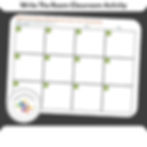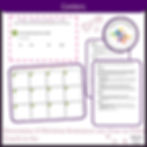Navigating the world of print can be challenging for students with special needs. Teachers often encounter difficulties in helping these students understand the basics of book orientation, print awareness, and comprehension. The goal is to scaffold these foundational skills effectively, ensuring students progress from their current levels to desired targets. Today, we'll explore strategies and goals designed to improve print awareness and comprehension for students with diverse learning needs.
Key Takeaway
Setting clear, measurable goals with specific objectives is crucial for improving print awareness and comprehension skills in special education. This approach ensures targeted interventions and trackable progress.
Detailed IEP Goals and Strategies
Annual Goal #1: Orientation to a Book Goal: By [date], [student's name] will demonstrate orientation to a book, improving print awareness from [current level] to [target level].
Objectives:
[Student's name] will identify the front and back of a book in 8/10 trials.
[Student's name] will demonstrate top to bottom orientation when holding a book in 8/10 trials.
[Student's name] will show left to right progression when handling a book in 8/10 trials.
Strategies:
Use tactile and visual markers to help students identify book orientation.
Engage in interactive read-aloud sessions where students can practice handling books correctly.
Student Scenario: Case Study: Alex's Journey with Book Orientation Alex, a second-grader, often struggled with holding books correctly, leading to confusion during reading activities. His teacher introduced tactile markers on book covers to indicate the front and back. During story time, Alex practiced orienting his book with his peers. Over time, he confidently identified the front and back, and even helped classmates. His print awareness significantly improved, making reading sessions more enjoyable.
Annual Goal #2: Comprehending Pictures Goal: By [date], [student's name] will demonstrate by pointing to pictures that pictures provide information, improving comprehension skills from [current level] to [target level].
Objectives:
[Student's name] will point to relevant pictures when asked questions about a story in 8/10 trials.
[Student's name] will match pictures to corresponding text in 8/10 trials.
[Student's name] will use pictures to predict story events in 8/10 trials.
Strategies:
Utilize picture books and ask questions that require students to point out details.
Pair text with pictures in activities to reinforce the connection between them.
Student Scenario: Case Study: Emma's Picture Comprehension Breakthrough Emma, a third-grader, found it challenging to understand the story from text alone. Her teacher used picture books and asked Emma to point out characters and events. Emma soon began matching pictures to the text, predicting story outcomes, and engaging more deeply in reading activities. Her comprehension skills soared, and she developed a newfound love for stories.
Annual Goal #3: Tracking Print Goal: By [date], [student's name] will follow words left to right and top to bottom with return sweep, improving print awareness from [current level] to [target level].
Objectives:
[Student's name] will track print left to right in 8/10 trials.
[Student's name] will follow print from top to bottom in 8/10 trials.
[Student's name] will use return sweep correctly in 8/10 trials.
Strategies:
Use finger-pointing or tracking tools to guide students' eyes across the text.
Practice with simple, repetitive text to solidify tracking skills.
Student Scenario: Case Study: Noah's Tracking Triumph Noah, a first-grader, often lost his place while reading. His teacher provided a tracking tool and guided Noah's finger under the words as he read. Through consistent practice, Noah mastered the left-to-right and top-to-bottom tracking, improving his reading fluency and confidence.
Annual Goal #4: Connecting Text and Pictures Goal: By [date], [student's name] will demonstrate by pointing that the print and picture give meaning to the book, improving comprehension skills from [current level] to [target level].
Objectives:
[Student's name] will point to text that matches the picture in 8/10 trials.
[Student's name] will explain the connection between text and picture in 8/10 trials.
[Student's name] will identify elements in pictures that reflect the story content in 8/10 trials.
Strategies:
Create matching games where students connect text and pictures.
Discuss how pictures support the story during reading sessions.
Student Scenario: Case Study: Mia's Connection Clarity Mia, a fourth-grader, struggled to see how pictures related to the text. Her teacher used matching games to connect words with images. Mia started explaining how pictures added to the story's meaning, which enhanced her comprehension and storytelling abilities.
Annual Goal #5: Recognizing Environmental Print Goal: By [date], [student's name] will recognize symbols and words in the classroom, school, and community, improving print awareness from [current level] to [target level].
Objectives:
[Student's name] will identify classroom labels in 8/10 trials.
[Student's name] will recognize outdoor labels in 8/10 trials.
[Student's name] will read community signs in 8/10 trials.
Strategies:
Use environmental print in the classroom and community walks.
Label items in the classroom and engage students in identifying these labels.
Student Scenario: Case Study: Liam's Environmental Print Adventure Liam, a first-grader, was unaware of the print around him. His teacher labeled classroom items and took Liam on community walks to identify signs and symbols. Liam soon recognized and read various labels, enhancing his print awareness and interaction with his environment.
Annual Goal #6: Distinguishing Letters and Words Goal: By [date], [student's name] will distinguish between letters, words, and numerals in a line of print, improving print awareness from [current level] to [target level].
Objectives:
[Student's name] will identify letters in a line of print in 8/10 trials.
[Student's name] will distinguish words in a line of print in 8/10 trials.
[Student's name] will differentiate numerals in a line of print in 8/10 trials.
Strategies:
Incorporate sorting activities that separate letters, words, and numerals.
Use visual aids and flashcards to reinforce differences.
Improving print awareness and comprehension skills in special education requires clear, targeted goals and consistent, engaging strategies. By breaking down these skills into manageable objectives, teachers can effectively support their students' reading development. Remember, every step forward is a success worth celebrating.
Explore our IEP Goal Bank, Lesson Plan Templates, and TeachTastic Store for more resources and tools to support your teaching.

































